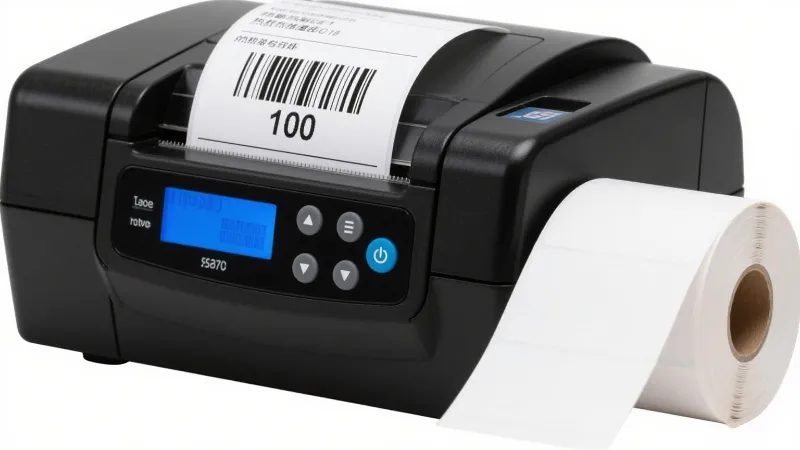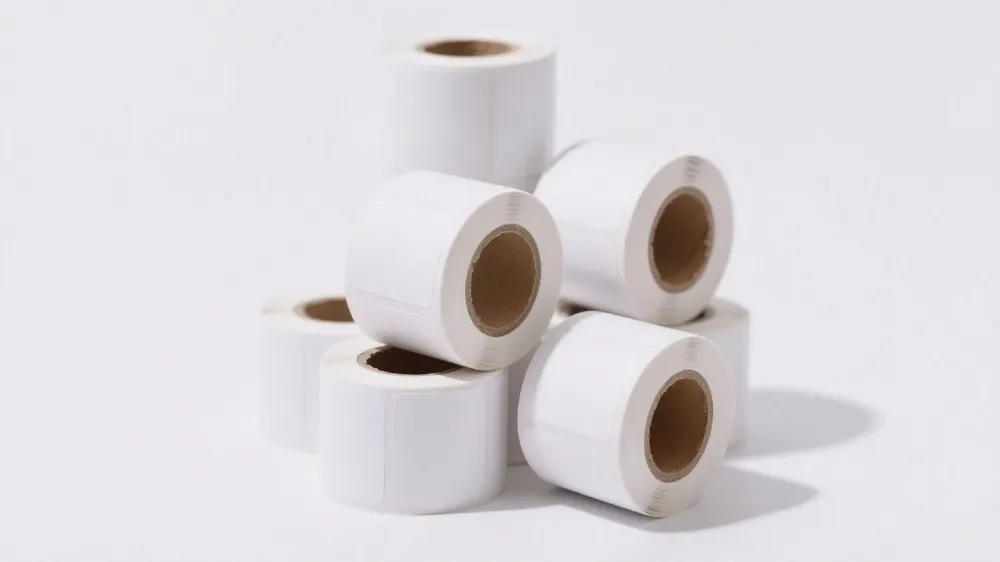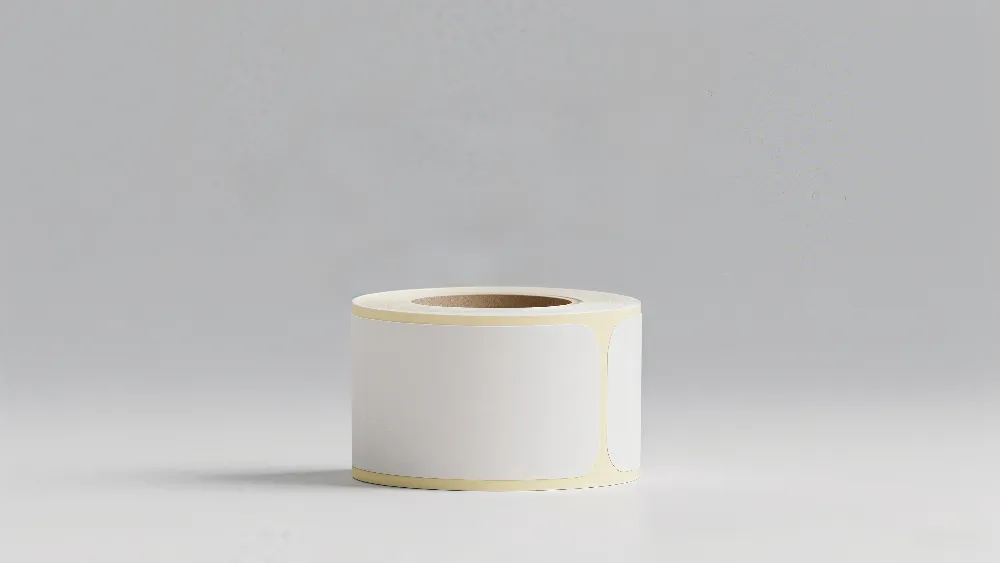
High-quality thermal labels stand out because of their key features that experts frequently highlight:
Exceptional print quality ensures that text, barcodes, and QR codes appear sharp and clear every time.
The adhesive is strong and reliable, sticking well to various surfaces such as cardboard, plastic, and metal.
These labels are durable, capable of withstanding water, heat, scratches, and aging.
Made from premium materials, ranging from basic paper to robust synthetics.
Designed to work seamlessly with thermal transfer printers, which helps the print last longer.
These key features are crucial as they enable businesses to operate up to 85% more efficiently after switching to thermal labels. This makes them a smart choice for enhanced performance and long-term cost savings.
Key Takeaways
Good thermal labels show clear words and pictures. They have glue that sticks well. They do not get ruined by water, heat, or scratches.
Picking the best label for your printer and job saves money. It also helps you not make mistakes.
Clean the surface before you put on a label. This helps the label stick better and stay on longer.
Using eco-friendly and recyclable labels helps the planet. It also helps your business be more green.
Test labels for how well they stick. Check if the print is clear and if you can scan them. This makes sure they work well when you use them.
Key Features
High-quality thermal labels work well because they have many important features. Each feature helps the labels do their job in tough places.
Print Quality
Print quality is very important for thermal labels. Clear printing makes barcodes, words, and pictures easy to read. This helps people scan them quickly in warehouses. Good print quality stops mistakes and saves time. Labels with sharp images, like 300 or 600 DPI, make barcodes easier to scan. Good printers keep the print clear. Bad printers can make blurry barcodes that cause problems.
Durability
Durability shows how well a label lasts each day. Labels in shipping and warehouses get wet, scratched, or hot. Synthetic materials like polypropylene and polyethylene fight water, scratches, and heat. Thermal transfer printing with wax-resin or resin ribbons makes labels that do not smudge or fade. Strong labels keep tracking details safe, even when handled roughly or put in bad weather.
Adhesive Strength
Adhesive strength keeps labels stuck from start to finish. In warehouses, labels face heat, cold, and wet air. Weak adhesives can make labels peel off or wrinkle. This can cause scan mistakes and slow down work. Strong adhesives, made for the right surface, stop these problems. Cold-resistant adhesives work in freezers. Permanent adhesives are good for shipping boxes. Cleaning the surface before sticking the label helps it stay on better.
Tip: Always put labels on in dry, steady conditions. This helps the adhesive work best and stops problems.
Compatibility
Compatibility with printers and jobs affects how well labels work and how much they cost. Some printers need special ribbons or parts, which can cost more. Picking good printer brands helps them last longer and break less. Updating the printer and keeping it clean also helps it last. Using the right labels for your printer and job stops mistakes and saves time.
Environmental Impact
Environmental impact is important for companies that want to be green. Many thermal labels use materials approved by groups like the Forest Stewardship Council (FSC). These groups make sure paper comes from forests that are cared for. Other labels have certifications like Environmental Product Declarations (EPD) and Earthsure. These show the company uses earth-friendly ways. Using recyclable and responsibly sourced materials cuts down on waste and helps the planet.
Key Features | Why It Matters | Example Benefit |
|---|---|---|
Print Quality | Makes barcodes and words easy to scan | Fewer mistakes in warehouses |
Durability | Handles water, heat, and scratches | Labels stay readable during shipping |
Adhesive Strength | Keeps labels on in hard places | Stops lost or unreadable labels |
Compatibility | Works with the right printer and job | Saves money and avoids mistakes |
Environmental Impact | Helps the planet and uses good materials | Meets green business goals |
All these features help thermal labels work better and last longer. Companies that look at these features can get better results, make fewer mistakes, and save money.
Print Quality

Clarity
Clarity is very important for thermal labels. Labels with clear text and barcodes are easy to read. Workers and machines can find information fast. Sharp labels help scanners make fewer mistakes. If labels are blurry, people can get confused. This can slow down the work. Machines need clear labels to avoid errors. They use special tools to find smudges or missing words. Crooked text is also a problem for machines. When labels are clear, both people and machines read them right. This helps work go faster and stops scanning mistakes.
Note: Clear labels help machines find almost all label problems. Manual checks can miss many mistakes.
Contrast
Contrast helps barcodes and words stand out on labels. A big difference between dark bars and light spaces is best. Scanners read barcodes better with strong contrast. Experts say the dark parts should be twice as dark as the background. This is called a 2:1 contrast ratio. High contrast helps scanners see details in any light. Dark bars on a light label work best for most scanners. Good contrast means fewer scanning mistakes. This keeps work moving without problems.
Scannability
Scannability shows how well machines can read a label. The way a label is printed matters a lot. Direct thermal printing makes sharp images for short use. These labels can fade if they get too much light. Faded labels are hard for scanners to read. Thermal transfer printing uses a ribbon to put ink on the label. This makes strong, dark barcodes that last a long time. These labels can handle heat and chemicals. They are good for tracking things for a long time. Picking the right printing method keeps labels easy to scan.
Durability
Water Resistance
Thermal labels often get wet or are in humid places. This happens a lot with food packaging and storage. Labels made from synthetic polyester are very waterproof. They keep sticking even if they get wet or cold. This makes them great for food in fridges or freezers. Polypropylene labels are cheaper and work well indoors with some moisture.
Synthetic polyester labels do not let water in and keep sticking in wet or cold places.
Polypropylene labels stop some water in easier jobs.
Food-grade waterproof labels follow safety rules to stop germs.
Dissolvable labels are used for a short time and melt away when wet.
Thermal printing with resin ribbons keeps the print from smudging or fading. Labels with special coatings or lamination also block water, oils, and scratches. Picking the right water-resistant label helps companies follow safety laws and keeps product details easy to read.
Heat Resistance
Good thermal labels must handle hot and cold without losing their print or stickiness. In factories, labels can get very hot. Regular labels might peel off, fade, or burn in these places. Special materials like polyimide and polyester can take high heat. Polyimide labels can handle over 500°F (260°C). Polyester labels can take up to 300°F (150°C). Some lab labels can even take more than 1000°F (538°C).
Label Material | Temperature Range Without Print Degradation | Typical Applications |
|---|---|---|
Polyimide | Electronics, PCB manufacturing | |
Polyester (PET) | Up to 300°F (150°C) or higher | Tire and rubber manufacturing |
Laboratory Labels | > 1000°F (538°C) | Crucibles, chemical analysis |
Heat-resistant adhesives, like silicone or acrylic, help labels stay on. Extra coatings and laminates give more protection. These things help labels last longer and keep words clear, even in tough places.
Abrasion Resistance
Shipping and moving things can rub labels on rough surfaces. Abrasion resistance means labels stay clear and whole during shipping. Industry rules like ASTM D7932 use machines to test how well labels fight wear. The Taber abrasion machine copies real rubbing to check strength.
Standard / Method | Description | Application to Thermal Labels |
|---|---|---|
ASTM D7932 | Abrasion wear testing using Taber machine | Main standard for label durability |
CSA C22.2 No. 0.15-15 | Canadian standard for abrasion resistance | Used in Canadian markets |
Taber Abrasion Machine | Rotating wheels simulate real-world abrasion | Common test for label wear |
Labels with strong abrasion resistance, like Metalphoto® labels, put images inside a hard aluminum layer. This keeps labels easy to read and tough, even after rough use. Good abrasion resistance helps shipping labels last longer and makes sure asset tags can be scanned the whole way.
Adhesive

Types
Thermal label adhesives come in a few main types. Each type is made for a special job. The adhesive you pick changes how well the label sticks. It also affects how long the label stays on. Here are the main types:
Acrylic adhesives: These make strong bonds that last a long time. They do not break down in sunlight, heat, or wet weather. Acrylic adhesives are good for outdoor use and tough places.
Rubber or resin adhesives: These stick fast and bend easily. They work on bumpy shapes and are good for quick jobs. But, they do not last as long in very hot or cold places.
Hot melt adhesives: These dry fast and hold tight. They are used in freezers and fast factories. Hot melt adhesives need the right heat to work well.
The way a surface feels also matters for sticking. Smooth glass and metal help adhesives stick better. Plastics that are slippery may need stronger adhesives to work well.
Surface Performance
Surface performance shows how well an adhesive sticks to things. The kind of material and how it feels are important. Smooth and clean surfaces help adhesives stick all the way. This means labels fall off less often. If a surface is rough or dirty, air can get trapped. This makes the label not stick as well. For example, rough steel makes more labels fall off than smooth steel. Cleaning or sanding the surface before labeling helps a lot.
Testing checks if adhesives can handle heat and pressure. In factories, adhesives must deal with heat and not let air in. These tests help companies pick the best adhesive for their needs.
Tip: Always clean and dry the surface before putting on a label. This easy step makes the label stick better and last longer.
Reliability
Reliability means the label stays where you put it. Things like wet air, heat, and sunlight can change how well adhesives work. Acrylic adhesives can handle these things and keep labels in place. Rubber adhesives are good for quick jobs but may not last in tough places.
How long the label needs to stay matters too. Labels for cold or outside use need special adhesives that fight water. Pressing down hard when putting on the label helps it stay on. Using the right adhesive for the surface keeps the label easy to read. Good adhesives stop labels from falling off or getting lost. This helps work go smoothly.
Compatibility
Printer Types
Thermal labels must match the printer type to work well. Two main types of thermal printers exist: direct thermal and thermal transfer. Each printer uses a different method to create images on the label.
Direct thermal printers use heat to make marks on special paper. These labels work best for short-term use, such as shipping or receipts. They do not need ink or ribbons. However, they can fade if exposed to sunlight or heat.
Thermal transfer printers use a ribbon to transfer ink onto the label. These labels last longer and resist water, chemicals, and abrasion. They suit long-term storage, asset tracking, and outdoor use.
Printer Type | Best For | Label Lifespan | Supplies Needed |
|---|---|---|---|
Shipping, receipts | Short-term | None | |
Thermal Transfer | Inventory, asset tags | Long-term | Ribbon |
Tip: Always check the printer model before buying labels. Some printers only accept certain label sizes or materials.
Application Needs
Different jobs need different labels. The right label depends on where and how people use it.
Shipping labels need to stick well and stay readable during transport.
Product labels must look good and last on shelves.
Cold storage labels need adhesives that work in freezers.
Outdoor labels must resist rain, sun, and dirt.
A company should list its needs before choosing a label. For example, a food company may need waterproof labels for frozen goods. A warehouse may need labels that scan fast and do not peel off boxes.
Note: Matching the label to the job helps avoid wasted time and money. The right choice keeps work moving and products safe.
Eco-Friendly
Materials
High-quality thermal labels often use eco-friendly materials. Many companies pick paper from forests that are managed well. The Forest Stewardship Council (FSC) checks these forests. FSC-certified paper helps keep forests and animals safe. Some companies use recycled paper to cut down on waste. This also saves energy and water. Some synthetic labels are eco-friendly too. They might use bioplastics made from plants. Others use materials that break down faster in landfills.
A few common eco-friendly materials are:
FSC-certified paper: Comes from forests that follow strict environmental rules.
Recycled paper: Uses less energy and water during production.
Biodegradable films: Break down naturally over time.
Compostable adhesives: Do not leave harmful residue.
Tip: Companies should ask suppliers for proof of eco-friendly certifications. This makes sure the labels meet green standards.
Recyclability
Recyclability is important for cutting down on waste. Many thermal labels now use materials that recycling centers accept. Paper labels with water-based adhesives can go in paper recycling bins. Some synthetic labels, like polypropylene, can be recycled if separated from other trash.
The table below shows common label types and their recyclability:
Label Type | Recyclable? | Special Instructions |
|---|---|---|
FSC Paper | Yes | Remove from plastic backing |
Recycled Paper | Yes | Keep dry for best results |
Polypropylene (PP) | Sometimes | Check local recycling rules |
Biodegradable Films | No | Compost instead |
Recyclable labels help companies reach their sustainability goals. They also attract customers who care about the environment. Picking the right label helps both businesses and the planet.
High-quality thermal labels work well when companies look at important things like print quality, how long they last, how well they stick, if they fit the printer, and if they are good for the environment. Before buying, businesses should try out the label’s stickiness, make sure barcodes scan well, and check if the print is clear. They also need to pick the right label for the job and see if it works with their printer. Managed print services help companies save money and make fewer mistakes. If companies do these things, they can pick labels that help them work better and save money for a long time.
FAQ
What is the difference between direct thermal and thermal transfer labels?
Direct thermal labels use paper that changes with heat. They are good for things used for a short time. Thermal transfer labels use a ribbon to put ink on the label. These labels last longer and can handle water and heat.
How can a business test label adhesive strength?
A business should stick the label on the surface they want. After one day, check if the label is still flat and not peeling. If it stays on, the adhesive is strong. Testing in real places gives the best answers.
Are thermal labels safe for food packaging?
Many thermal labels follow food safety rules. Companies should pick labels that say “food-safe” or “FDA-approved.” These labels do not let bad chemicals touch food.
Can thermal labels be recycled?
Some thermal labels are made from things you can recycle. Paper labels with water-based adhesives can go in normal recycling bins. Synthetic labels might need special recycling. Always check your local recycling rules.
What causes thermal labels to fade?
Sunlight, heat, or chemicals can make labels fade. Direct thermal labels fade faster than thermal transfer labels. Picking the right label for where it will be used helps stop fading.
